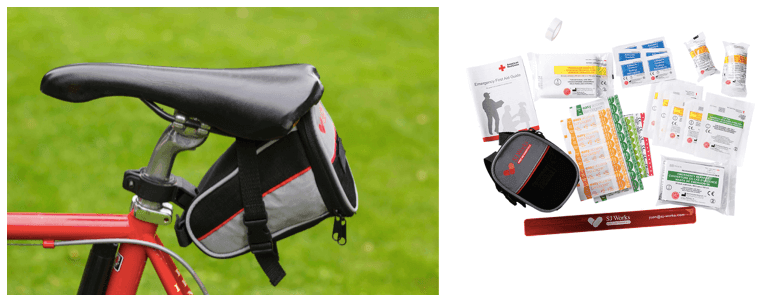
My children and I enjoy taking short bicycle trips across the valley. Whether it’s a trip on designated bike paths or a two hour jaunt up into the foothills, we never leave our car without our bicycle first aid kit.
There are bicycle first aid kits you can purchase for around $20. I prefer to make my own, and customize it for the sorts of emergencies a parent can expect with children. Because this kit will travel with you on your bicycle, it must be compact and lightweight. With the items listed below, you should be well prepared for the usual scrapes, sprains, cuts, and bug bites that typically happen on family bicycle outings.
How to assemble your bicycle first aid kit
The first thing you will need is a water proof container. A zippered or plastic or vinyl cosmetic bag works very well; these can usually be purchased at the dollar store or discount bin for less than 50¢. The container should be at least 4 inches long and three inches wide to accommodate the basic first aid supplies you will need. As an extra precaution against moisture, I also place my bandages and gauze in snack size ziploc containers.
To put inside your kit, you will need the following first aid supplies:
4 large (4 x 4 sized) nonstick telfa pads. These are used to cover large scrapes on the arm or leg.
8 adhesive bandages in assorted sizes. Include at least one bandage large enough for elbow or knees, and a couple of tiny ones for finger cuts.
Rolled gauze will keep the telfa pads secured to the skin and can be used to wrap a sprained knee or wrist. Self adhesive is fine.
A roll of adhesive tape to secure the gauze. Tape is also helpful to immobilize a sprained finger or ankle.
Some packages of disinfectant wipes to help cleanse the wound.
A tube of antibacterial ointment to disinfect the wound or scrape.
Some chewable children’s pain reliever that doesn’t require water.
A container of Cortisone cream for poison ivy, scrapes, or bug bites.
A pair of tweezers to remove splinters.
An instant ice pack for sprains, bumps, and headaches.
A tiny container of saline solution to flush dirt or debris out of eyes (this can usually be found in the optical department of your drug store).
If you haven’t already, consider taking a basic first aid class through an community education program and learn how to treat these minor emergencies. For more information about basic first aid for children, visit http://pediatrics.about.com/od/firstaid/First_Aid_for_Children.htm.
